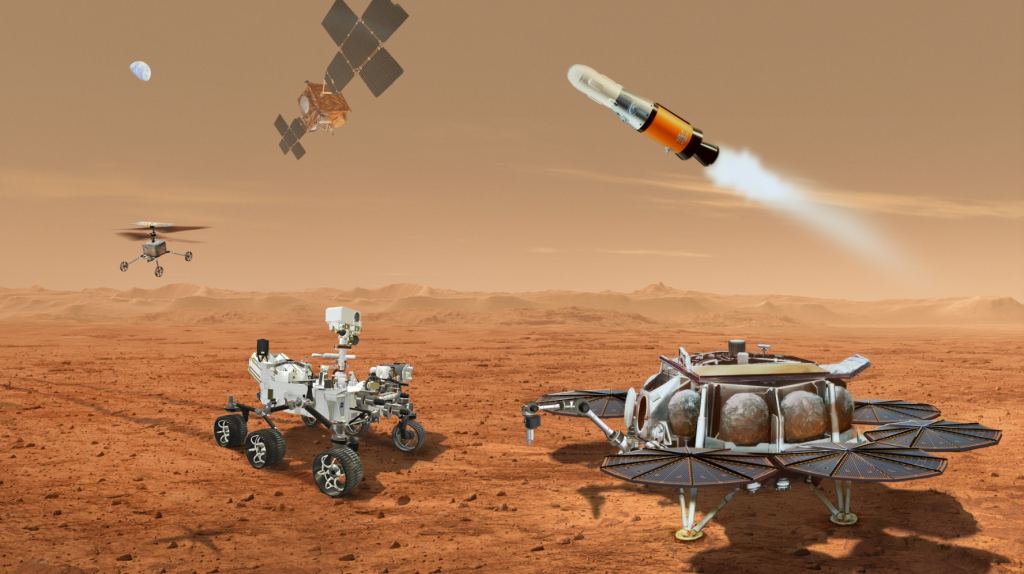NASA’s upcoming Mars Sample Return mission plan just received a glow-up: it will now carry a pair of twin helicopters , each capable of retrieving samples and delivering them to the ascent vehicle for return to Earth. The helicopters take the place of a previously planned fetch rover, which has now been ditched from the plan altogether. The fetch rover would have required a second lander, while the helicopters can fit alongside the ascent vehicle, simplifying the mission and reducing its overall cost and complexity.
The decision was announced in a press release earlier this week, which indicated that NASA had finished the system requirements review for the Sample Return mission. Remove All Ads on Universe Today Join our Patreon for as little as $3! Get the ad-free experience for life Sample return efforts are already in progress, as the Perseverance Rover is actively collecting samples from scientifically important sites in Jezero Crater on Mars, and has been since early 2021. The original plan was for Perseverance to cache the sample tubes for the fetch rover to collect at a later date.
However, Perseverance is still going strong, and NASA expects that it will last long enough to deliver the samples to the ascent vehicle itself. The two helicopters will provide redundant delivery capabilities, should Perseverance fail. Several recent developments made the updated plan possible.
Perseverance’s longevity is one of these. The other is the unadulterated success of Ingenuity, Perseverance’s companion helicopter, which made the first-ever powered flight on Mars back in 2021. It has now lasted over a year longer than its expected operational lifetime, having performed 29 flights in that time.
More than just a proof of concept, Ingenuity has demonstrated that powered flight vehicles can be adept, versatile workhorses for a variety of tasks on Mars. At a media press conference on July 27, Richard Cook, Mars Sample Return Program Manager at the Jet Propulsion Laboratory, indicated that the new helicopters will be distinct from Ingenuity in two ways. The first is that they will feature a set of small wheels rather than landing legs “that allow the helicopters to traverse across the surface on the ground as well as fly…and secondly, each of the helicopters will have a little arm that can reach down and grab onto the…sample tubes.
” These capabilities will only be necessary if Perseverance itself cannot deliver the samples, but their presence is a comforting insurance policy in case things go south with the rover. The helicopters, along with the lander carrying the ascent stage, are expected to launch from Earth in 2028 (an orbiter built by the European Space Agency [ESA] will precede them in 2027). After Perseverance and/or the helicopters retrieve the samples, the ascent stage will carry them to Mars orbit and rendezvous with the orbiter, before returning the precious core samples to Earth in 2033.
The changes to the Mars Sample Return Program bear out the recommendations of the Planetary Science Decadal Survey, released back in April 2022. The survey indicated that a successful Mars sample return ought to be the highest scientific priority for NASA’s robotic exploration efforts this decade, but not at the expense of other missions. “Its cost should not be allowed to undermine the long-term programmatic balance of the planetary portfolio,” the survey cautioned.
Restructuring the mission to make a second rover and lander unnecessary should help keep costs manageable, while Ingenuity’s success offers compelling evidence that the new plan ought to be feasible. If all goes well, scientists may soon be spoiled with riches of Martian dust and rock. Alongside NASA’s and ESA’s efforts, a Chinese sample return mission is slated to return Martian soil to Earth by 2031, and a Japanese mission plans to bring samples back from Mars’ largest moon Phobos in 2029.
While in-situ geology performed by rovers like Perseverance and its predecessor Curiosity can tell us a lot about conditions on Mars, there are investigative tools and techniques possible in laboratories back on Earth that no rover can match. Sample return missions will allow scientists to study the minerals in more detail, uncovering the history of the Red Planet and, potentially, its ecosystems (if it ever had any). The funding for the project is falling into place too.
Yesterday, the US Senate released its FY23 draft spending bill, proposing to give NASA the funds it requested for the next year to move the project forward. You can read more about the sample return mission here: https://www. nasa.
gov/press-release/nasa-will-inspire-world-when-it-returns-mars-samples-to-earth-in-2033 Featured Image: artist’s rendering of the Mars Sample Return Program infrastructure. Credit: NASA/JPL-Caltech. .
From: universetoday
URL: https://www.universetoday.com/156946/the-mars-sample-return-mission-will-take-two-helicopters-to-the-red-planet-to-help-retrieve-samples/



